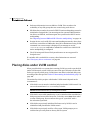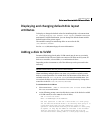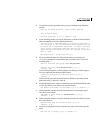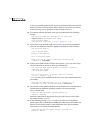
96 Administering disks
Installing and formatting disks
3 If you want to use enclosure-based naming, use vxdiskadm to add a
non-persistent simple disk to the bootdg disk group, change back to the
enclosure-based naming scheme, and then run the following command:
# /etc/vx/bin/vxdarestore
Note: If not all the disks in bootdg go into the error state, you need only run
vxdarestore to restore the disks that are in the error state and the objects that
they contain.
Persistent simple or nopriv disks in non-boot disk groups
If an imported disk group, other than bootdg, consists only of persistent simple
and/or nopriv disks, it is put in the “online dgdisabled” state after the
change to the enclosure-based naming scheme.
To remove the error state for persistent simple or nopriv disks in non-boot
disk groups
1 Deport the disk group using the following command:
# vxdg deport diskgroup
2 Use the vxdarestore command to restore the failed disks, and to recover the
objects on those disks:
# /etc/vx/bin/vxdarestore
3 Re-import the disk group using the following command:
# vxdg import diskgroup
Installing and formatting disks
Depending on the hardware capabilities of your disks and of your system, you
may either need to shut down and power off your system before installing the
disks, or you may be able to hot-insert the disks into the live system. Many
operating systems can detect the presence of the new disks on being rebooted. If
the disks are inserted while the system is live, you may need to enter an
operating system-specific command to notify the system.
If the disks require low or intermediate-level formatting before use, use the
operating system-specific formatting command to do this.
Note: SCSI disks are usually preformatted. Reformatting is needed only if the
existing formatting has become damaged.
The following sections provide detailed examples of how to use the vxdiskadm
utility to place disks under VxVM control in various ways and circumstances.


















